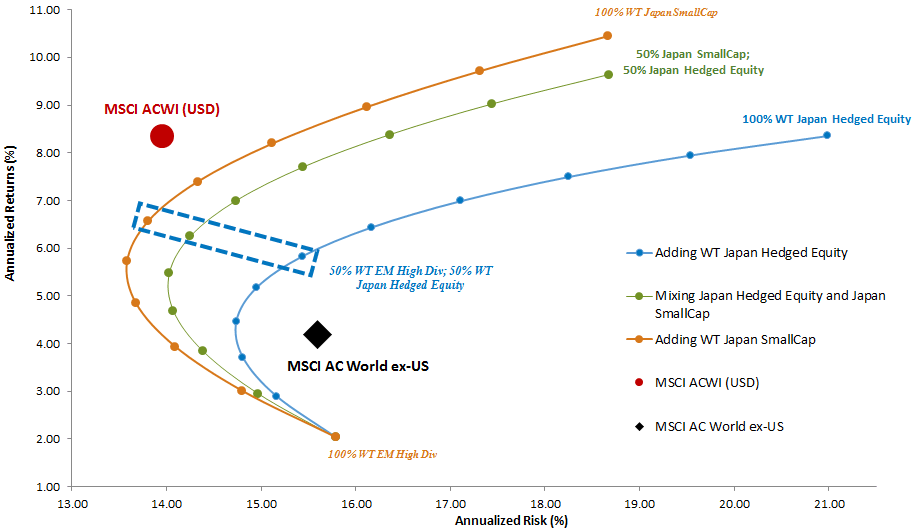Blending Emerging Markets with Japan to Manage Volatility


The last six years have brought no shortage of surprises, such as the bear market in commodities, divergent monetary policies and, most recently, the Trump presidency.
From a global markets perspective, there have been large dispersions in the returns of different regions around the world.
U.S. equity markets have generated impressive returns and far and away outperformed international markets such as Europe, Japan and emerging market (EM) equities.
This is clearly evident to us when we contrast the return profile of the MSCI ACWI Index (which includes the U.S. markets) and the MSCI AC World ex-US Index below. Even with the United States comprising just 50% of the exposure in the MSCI ACWI Index on average over the last seven years, this Index with the U.S. still managed to outperform the MSCI AC World ex-US by 416 basis points (bps), and it did so with 164 bps lower volatility.1
EM Drag
Emerging market equities were a significant drag on the performance of the MSCI AC World ex-US, culminating in extreme pessimism in January 2016. Since then, emerging market equities have staged a significant rally, leading many investors to reconsider their allocations.
Japan, on the other hand, has maintained a strong fundamental backdrop to attract investment in both the large-cap exporters and domestically focused small-cap equities. The recent resurgence of interest in emerging market equities has led us to explore potentially complementary allocations.
What Emerging Markets and Japan Have in Common: China
Japan can be one of most cyclical areas of the market relative to trends in global growth. China, despite the competitive and strained ties portrayed in the media, is a large importer of Japanese goods and represents one of the growth drivers for Japan.
Below we exhibit a study of the risk and return characteristics of blending different WisdomTree Japan and emerging markets strategies.
Adding WT EM High Dividend to WT Japan Allocations
(2/1/2010–1/31/2017)


For definitions of indexes in the chart, visit our glossary.
Complementing Your Exposures
This analysis looks at different ways of constructing global ex-U.S. combinations of exposure.
Achieving Lower Volatility than the MSCI AC World ex-US
- Japan Hedged and EM Blends: Despite both Japan and emerging markets having individually high levels of volatility, a unique 50/50 blend of the WisdomTree Japan Hedged Equity Index (WT Japan Hedged Equity) and the WisdomTree Emerging Markets High Dividend Index (WT EM High Div) had a lower volatility than the MSCI AC World ex-US and higher returns over this period. One particularly interesting comparison is that of the 50% WisdomTree EM High Dividend Index and 50% WisdomTree Japan Hedged Equity Index, which returned 5.83% compared to the MSCI AC World ex-US’s 4.19% with less volatility.
- Lowering Risk Further: The WisdomTree Japan SmallCap Dividend Index (WT Japan SmallCap), which does not hedge the yen, had strong returns and a lower volatility profile than the WT Japan Hedged Equity Index. Adding this into combinations of emerging markets would have provided strong risk mitigation over this period. The WisdomTree Emerging Markets High Dividend combined with the unhedged WisdomTree Japan SmallCap Dividend Index is the orange line in the chart, and a 50/50 blend of the two, WT Japan SmallCap and EM High Dividend, returned 6.57% compared to the MSCI AC World ex-US of 4.19%.
- The line in green shows the blending of a 50/50 split of Japan Hedged Equity and Japan SmallCap Dividend allocation at one end and EM High Dividend on the other end. This shows a realistic allocation to Japan that is tuned into the weakening yen and its potential benefits to exporters as well as Team Abe’s commitment to generating growth at home, which small caps stand to benefit from. For those who believe the yen is going to be a critical driver of Japanese markets, this combination could be a good middle ground of Japanese exposure.
In the case of the WisdomTree Japan Hedged Equity Index, the EM portion benefited from having the U.S. dollar hedge by lowering the net dollar exposure of the blend. This is a point that Jeremy Schwartz has brought up before when addressing a strong U.S. dollar. Contrast this with the WisdomTree Japan SmallCap Dividend Index, which is unhedged and better represents a locally focused view on Japan.
Hedging the yen has added to volatility for Japanese exposures due to the negative correlation between Japanese stocks and the currency. The properties of the yen when unhedged on the WT Japan SmallCap, combined with the WT Japan Hedged Equity (a strong dollar play) and the WT EM High Dividend (a weak dollar beneficiary), provide a unique set of international exposures.
Important Risks Related to this Article
Investments focused in Japan increase the impact of events and developments associated with the region, which can adversely affect performance.Hedging can help returns when a foreign currency depreciates against the U.S. dollar, but it can hurt when the foreign currency appreciates against the U.S. dollar.

